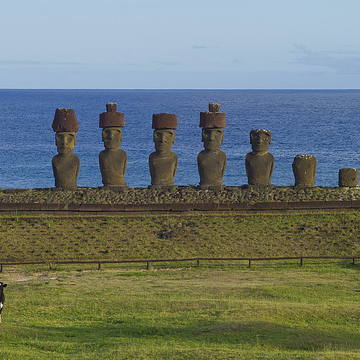Mysteries of Easter Island - Rapa Nui (Part I)Easter Island, some 3700 kms from the western coast of
Mysteries of Easter Island - Rapa Nui (Part I)Easter Island, some 3700 kms from the western coast of Chile is one of the most remote inhabited islands in the world. Around 300 AD indigenous Polynesian tribesmen left their homes in canoes in search of a new world and arrived at the Anakena beach. From then until Easter Sunday in the year 1722 (how the island got its name) when Dutch settlers arrived, the local community thrived in a world of their own, sheltered from all the trappings and progress of the new world. Soon after the arrival of the Europeans, they encountered problems like new diseases they were not immune to, slavery, slaughter, and oppression. By the end of the 18th century the population plummeted to 111 individuals. Contact with western civilization, slave trades, and spread of diseases like smallpox decimated the population and destroyed their wonderfully distinct culture, most of it gone forever. While western influence may have hastened their ruination, Rapa Nui were on the brink of becoming a lost civilization for a long time. Some experts attributed their decimation to ecological catastrophe whilst others blame them for bringing their own doom by wanton destruction of nature (discussed in depth in the second part of this series).The Rapa Nui built shrines and erected enormous stone figures known as moai that represent their ancestors (the subject of the third part of this series). The unique architecture and sculpture of these people is displayed in the scattered moais around the island, and the ahu (ceremonial platform the most colossal is the Ahu Tongariki with 15 moai. About 900 statues and more than 300 ceremonial platforms are estimated to be around the island; that part of the island is classified as a World Heritage site by the UNESCO World Heritage Centre. There are many caves (ana) and rock art sites around the coast of the island displaying the visually stunning, versatile talents of the Rapa Nui in the forms of pictographs and petroglyphs; also noteworthy is their pictographic form of writing (Rongo Rongo), so far undeciphered. The Easter Island Statue Project (EISP) researchers are working towards unravelling the mystery of the long lost civilization.–RB.Further information: http://bit.ly/1LA6Aachttp://bit.ly/1gRI1bLhttp://bit.ly/1EDQlRtImage: http://bit.ly/1Ii6lJVhttp://bit.ly/1elisy0 -- source link
#easter island#rapa nui#chile#polynesia#remote#travel#science#archaeology#statue

